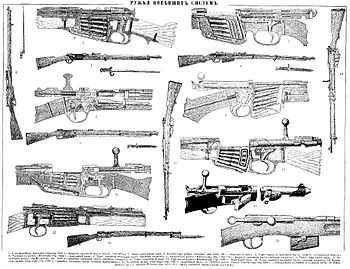Dutch Mannlicher
| Dutch Mannlicher M1895 | |
|---|---|
|
Dutch Mannlicher Model 1895 | |
| Type | Service rifle, Bolt-action rifle |
| Place of origin |
|
| Service history | |
| In service | 1895–1945 |
| Used by | Netherlands, Germany, Portugal |
| Wars | World War I, World War II |
| Production history | |
| Designer | Ferdinand von Mannlicher |
| Designed | 1895 |
| Manufacturer |
Steyr Mannlicher Hembrug Zaandam |
| Produced | 1895–1945 |
| Variants | M95 long rifle, M95 pioneer rifle, M95 artillery rifle, M95 short rifle |
| Specifications | |
| Cartridge | 6.5×53mmR |
| Action | Bolt-action |
| Feed system | 5-round en-bloc clip |
The Dutch Mannlicher, also known as the M.95 (Model 1895), was the service rifle of the Armed forces of the Netherlands between 1895 and 1945 which replaced the obsolete Beaumont-Vitali M1871/88. At first it was produced by Steyr Mannlicher for the Dutch, but after 1904, production took place under license at Hembrug Zaandam in the Netherlands. It was based on the earlier Mannlicher 1893 offered by Steyr to Romania, which was itself a somewhat modernized version of the German Model 1888 also known as the Commission Rifle. Both Dutch and Romanian rifles fired the same rimmed 6.5×53 mmR cartridge often referred to as "Romanian" or "Dutch 6.5".
The Dutch issued about 470,000 M.95s. The cartridge also saw limited success as a sporting round, including use by the elephant hunter W. D. M. Bell.
The M.95 was fairly modern when adopted, but painfully obsolete by the end of its service life. The Dutch military lacked the funds to replace it; and as such it remained in service for 47 years, making it one of the world's longest serving issue rifles. A staggering number of 9 variants (largely carbines differing only in sling swivels) were produced, among which were:

- No.1 cavalry introduced 1886
- No.2 for the Koninklijke Marechaussee with a folding bayonet
- No.3 pioneer, artillery model
- Karabijn No.4, a shortened M.95 (designed in 1909) created for the Dutch bicycle troops that had a wooden fairing on the left side of the magazine.
- M.95 Loopgraafgeweer, a M.95 (designed in 1916) with a periscope designed for trench warfare.
Around 1930 new models of No.1, No.2, No.3 and No.4 were introduced, in 1936 a shorter No.5 carbine model was introduced.
During the German invasion in 1940, light infantry armed with the M.95 proved to be easily outgunned when confronting the German troops armed with large numbers of light machine guns, sub-machine guns like the MP40 and rifles like the Karabiner 98k. In 1942, Royal Netherlands East Indies troops were issued with American and British arms, ending the use of the M.95, though postwar some East Indian rifles were refitted to use .303 British ammunition and issued as constabulary arms.

| ||||||||||||||||||||||||
